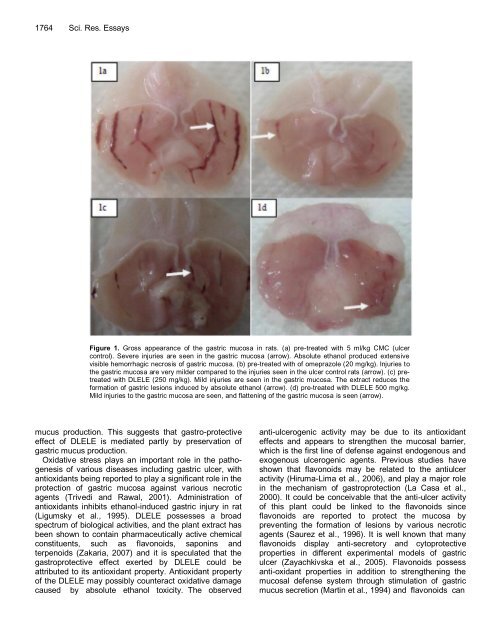Download complete issue (pdf 3360kb) - Academic Journals
Download complete issue (pdf 3360kb) - Academic Journals
Download complete issue (pdf 3360kb) - Academic Journals
You also want an ePaper? Increase the reach of your titles
YUMPU automatically turns print PDFs into web optimized ePapers that Google loves.
1764 Sci. Res. Essays<br />
Figure 1. Gross appearance of the gastric mucosa in rats. (a) pre-treated with 5 ml/kg CMC (ulcer<br />
control). Severe injuries are seen in the gastric mucosa (arrow). Absolute ethanol produced extensive<br />
visible hemorrhagic necrosis of gastric mucosa. (b) pre-treated with of omeprazole (20 mg/kg). Injuries to<br />
the gastric mucosa are very milder compared to the injuries seen in the ulcer control rats (arrow). (c) pretreated<br />
with DLELE (250 mg/kg). Mild injuries are seen in the gastric mucosa. The extract reduces the<br />
formation of gastric lesions induced by absolute ethanol (arrow). (d) pre-treated with DLELE 500 mg/kg.<br />
Mild injuries to the gastric mucosa are seen, and flattening of the gastric mucosa is seen (arrow).<br />
mucus production. This suggests that gastro-protective<br />
effect of DLELE is mediated partly by preservation of<br />
gastric mucus production.<br />
Oxidative stress plays an important role in the pathogenesis<br />
of various diseases including gastric ulcer, with<br />
antioxidants being reported to play a significant role in the<br />
protection of gastric mucosa against various necrotic<br />
agents (Trivedi and Rawal, 2001). Administration of<br />
antioxidants inhibits ethanol-induced gastric injury in rat<br />
(Ligumsky et al., 1995). DLELE possesses a broad<br />
spectrum of biological activities, and the plant extract has<br />
been shown to contain pharmaceutically active chemical<br />
constituents, such as flavonoids, saponins and<br />
terpenoids (Zakaria, 2007) and it is speculated that the<br />
gastroprotective effect exerted by DLELE could be<br />
attributed to its antioxidant property. Antioxidant property<br />
of the DLELE may possibly counteract oxidative damage<br />
caused by absolute ethanol toxicity. The observed<br />
anti-ulcerogenic activity may be due to its antioxidant<br />
effects and appears to strengthen the mucosal barrier,<br />
which is the first line of defense against endogenous and<br />
exogenous ulcerogenic agents. Previous studies have<br />
shown that flavonoids may be related to the antiulcer<br />
activity (Hiruma-Lima et al., 2006), and play a major role<br />
in the mechanism of gastroprotection (La Casa et al.,<br />
2000). It could be conceivable that the anti-ulcer activity<br />
of this plant could be linked to the flavonoids since<br />
flavonoids are reported to protect the mucosa by<br />
preventing the formation of lesions by various necrotic<br />
agents (Saurez et al., 1996). It is well known that many<br />
flavonoids display anti-secretory and cytoprotective<br />
properties in different experimental models of gastric<br />
ulcer (Zayachkivska et al., 2005). Flavonoids possess<br />
anti-oxidant properties in addition to strengthening the<br />
mucosal defense system through stimulation of gastric<br />
mucus secretion (Martin et al., 1994) and flavonoids can

















